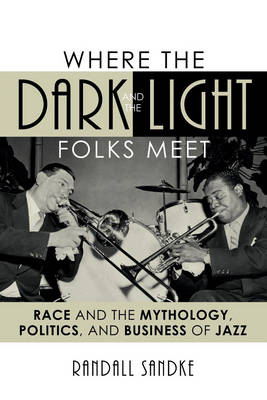
Where the Dark and the Light Folks Meet
Race and the Mythology, Politics, and Business of Jazz
Seiten
2014
Rowman & Littlefield (Verlag)
978-1-4422-4354-5 (ISBN)
Rowman & Littlefield (Verlag)
978-1-4422-4354-5 (ISBN)
Sandke tackles the stubborn and controversial question of whether jazz is the product of an insulated African-American environment, shut off from the rest of society by strictures of segregation and discrimination; or whether it is more properly understood as the juncture of a variety of influences under the broader umbrella of American culture.
Where the Dark and the Light Folks Meet tackles a controversial question: Is jazz the product of an insulated African-American environment, shut off from the rest of society by strictures of segregation and discrimination, or is it more properly understood as the juncture of a wide variety of influences under the broader umbrella of American culture? This book does not question that jazz was created and largely driven by African Americans, but rather posits that black culture has been more open to outside influences than most commentators are likely to admit. The majority of jazz writers, past and present, have embraced an exclusionary viewpoint.
Where the Dark and the Light Folks Meet begins by looking at many of these writers, from the birth of jazz history up to the present day, to see how and why their views have strayed from the historical record. This book challenges many widely held beliefs regarding the history and nature of jazz in an attempt to free jazz of the socio-political baggage that has so encumbered it. The result is a truer appreciation of the music and a greater understanding of the positive influence racial interaction and jazz music have had on each other.
Where the Dark and the Light Folks Meet tackles a controversial question: Is jazz the product of an insulated African-American environment, shut off from the rest of society by strictures of segregation and discrimination, or is it more properly understood as the juncture of a wide variety of influences under the broader umbrella of American culture? This book does not question that jazz was created and largely driven by African Americans, but rather posits that black culture has been more open to outside influences than most commentators are likely to admit. The majority of jazz writers, past and present, have embraced an exclusionary viewpoint.
Where the Dark and the Light Folks Meet begins by looking at many of these writers, from the birth of jazz history up to the present day, to see how and why their views have strayed from the historical record. This book challenges many widely held beliefs regarding the history and nature of jazz in an attempt to free jazz of the socio-political baggage that has so encumbered it. The result is a truer appreciation of the music and a greater understanding of the positive influence racial interaction and jazz music have had on each other.
Randall Sandke has been a professional jazz musician for over 30 years. He is the author of Harmony for a New Millennium: An Introduction to Metatonal Music (2002) and has contributed to The Oxford Companion To Jazz and the Annual Review of Jazz Studies (2000).
| Erscheint lt. Verlag | 1.12.2014 |
|---|---|
| Reihe/Serie | Studies in Jazz |
| Verlagsort | Lanham, MD |
| Sprache | englisch |
| Maße | 149 x 220 mm |
| Gewicht | 426 g |
| Themenwelt | Kunst / Musik / Theater ► Musik ► Jazz / Blues |
| Sozialwissenschaften | |
| ISBN-10 | 1-4422-4354-6 / 1442243546 |
| ISBN-13 | 978-1-4422-4354-5 / 9781442243545 |
| Zustand | Neuware |
| Haben Sie eine Frage zum Produkt? |
Mehr entdecken
aus dem Bereich
aus dem Bereich
zur politischen Ästhetik des Jazz
Buch | Hardcover (2023)
Phillip Reclam (Verlag)
38,00 €
Die Geschichte des Jazz in Deutschland
Buch | Softcover (2021)
Reclam, Philipp (Verlag)
20,00 €


